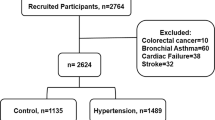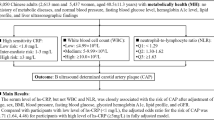Abstract
High blood pressure (HBP) has been associated with elevated C-reactive protein (CRP), a marker of chronic mild inflammation. However, the association between HBP and other inflammatory markers, particularly interleukin 6 (IL-6) and tumour necrosis alpha (TNF-α), has not been evaluated in well-controlled studies. We examined the cross-sectional relationship between IL-6, TNF-α, and CRP and HBP in a random sample of 196 healthy subjects. All markers were measured in duplicate with high-sensitivity ELISA tests. Three blood pressure (BP) measurments were averaged for the analysis, and subjects with systolic BP ⩾140 and/or diastolic BP ⩾90 mmHg were considered hypertensive. Log binomial regression was used to estimate multivariate-adjusted prevalence ratios (PR) of HBP. Of the subjects, 40% (79) were hypertensive (mean age: 44 years; range 30–64). After adjustment for age, sex, body mass index, family history of HBP, and the level of the other inflammatory markers, subjects in the second (PR: 3.10, P=0.003), third (PR: 2.32; P=0.031), and fourth quartiles (PR: 2.30; P=0.036) of IL-6 were more than twice as likely to be hypertensive than those in the first quartile. Corresponding PR estimates for TNF-α levels were 1.41 (P=0.014) for the second; 1.59 (P=0.001) for the third; and 1.61 (P=0.025) for the fourth quartile. The CRP–HBP association was not statistically significant. Our results suggest that TNF-α and IL-6 could be independent risk factors for HBP in apparently healthy subjects. Nevertheless, the temporal relationship between elevated inflammation markers and HBP should be ascertained in prospective cohort studies.
This is a preview of subscription content, access via your institution
Access options
Subscribe to this journal
Receive 12 digital issues and online access to articles
$119.00 per year
only $9.92 per issue
Buy this article
- Purchase on Springer Link
- Instant access to full article PDF
Prices may be subject to local taxes which are calculated during checkout
Similar content being viewed by others
References
Ridker PM et al. Inflammation, aspirin, and the risk of cardiovascular disease in apparently healthy men. N Engl J Med 1997; 336: 973–979.
Ridker PM et al. C-reactive protein and other markers of inflammation in the prediction of cardiovascular disease in women. N Engl J Med 2000; 342: 836–843.
Ridker PM et al. Plasma concentration of interleukin-6 and the risk of future myocardial infarction among apparently healthy men. Circulation 2000; 101: 1767–1772.
Harris TB et al. Associations of elevated interleukin-6 and C-reactive protein levels with mortality in the elderly. Am J Med 1999; 106: 506–512.
Volpato S et al. Cardiovascular disease, interleukin-6, and risk of mortality in older women: the women's health and aging study. Circulation 2001; 103: 947–953.
Bautista LE et al. Is C-reactive protein an independent risk factor for essential hypertension? J Hypertens 2001; 19: 857–861.
Chul SK et al. High sensitivity c-reactive protein as an independent risk factor for essential hypertension. Am J Hypertens 2003; 16: 429–433.
Bautista LE et al. Association between C-reactive protein and hypertension in healthy middle-aged men and women. Coron Artery Dis 2004; 15 (in press).
Rifai N et al. Inflammatory markers in men with angiographically documented coronary heart disease. Clin Chem 1999; 45: 1967–1973.
Chae CU et al. Blood pressure and inflammation in apparently healthy men. Hypertension 2001; 38: 399–403.
Ito H et al. Association of serum tumour necrosis factor-alpha with serum low-density lipoprotein-cholesterol and blood pressure in apparently healthy Japanese women. Clin Exp Pharmacol Physiol 2001; 28: 188–192.
Furumoto T et al. Association of cardiovascular risk factors and endothelial dysfunction in japanese hypertensive patients: implications for early atherosclerosis. Hypertens Res 2002; 25: 475–480.
Mendall MA et al. Relation of serum cytokine concentrations to cardiovascular risk factors and coronary heart disease. Heart 1997; 78: 273–277.
Sheu WHH et al. Plasma tumor necrosis factor alpha levels and insulin sensitivity in hypertensive subjects. Clin Exp Hypertens 2000; 22: 595–606.
Baumann H, Gauldie J . The acute phase response. Immunol Today 1994; 15: 74–80.
Bautista L et al. Prevalencia de Factores de Riesgo para Enfermedades Crónicas No Transmisibles en la Población de Bucaramanga. Encuesta Basal del Programa CARMEN. UIS 2000. Bucaramanga.
Perloff D et al. Human blood pressure determination by sphygmomanometry. Circulation 1993; 88: 2460–2470.
Wacholder S . Binomial regression in GLIM: estimating risk ratios and risk differences. Am J Epidemiol 1986; 123: 174–184.
Greenland S . Modeling and variable selection in epidemiologic analysis. Am J Public Health 1989; 79: 340–349.
Tsiatis AA . A note on a goodness-of-fit test for the logistic regression model. Biometrika 1980; 67: 250–251.
Yudkin JS et al. C-reactive protein in healthy subjects: associations with obesity, insulin resistance, and endothelial dysfunction: a potential role for cytokines originating from adipose tissue? Arterioscler Thromb Vasc Biol 1999; 19: 972–978.
Fernandez-Real JM et al. Circulating interleukin 6 levels, blood pressure, and insulin sensitivity in apparently healthy men and women. J Clin Endocrinol Metab 2001; 86: 1154–1159.
Woods A et al. Genetics of inflammation and risk of coronary artery disease: the central role of interleukin-6. Eur Heart J 2000; 21: 1574–1583.
Tilg H, Dinarello CA, Mier JW . IL-6 and APPs: anti-inflammatory and immunosuppressive mediators. Immunol Today 1997; 18: 428–432.
Fishman D et al. The effect of novel polymorphisms in the interleukin-6 (IL-6) gene on IL-6 transcription and plasma IL-6 levels, and an association with systemic-onset juvenile chronic arthritis. J Clin Invest 1998; 102: 1369–1376.
Brull DJ et al. The effect of the interleukin-6-174G>C promoter gene polymorphism on endothelial function in healthy volunteers. Eur J Clin Invest 2002; 32: 153–157.
Humphries SE et al. The interleukin-6 -174 G/C promoter polymorphism is associated with risk of coronary heart disease and systolic blood pressure in healthy men. Eur Heart J 2001; 22: 2243–2252.
Losito A et al. Association of interleukin-6 -174G/C promoter polymorphism with hypertension and left ventricular hypertrophy in dialysis patients. Kidney Int 2003; 64: 616–622.
Pola R et al. The -174 G/C polymorphism of the interleukin-6 gene promoter and essential hypertension in an elderly Italian population. J Hum Hypertens 2002; 16: 637–640.
Bhagat K, Vallance P . Inflammatory cytokines impair endothelium-dependent dilatation in human veins in vivo. Circulation 1997; 96: 3042–3047.
Hingorani AD et al. Acute systemic inflammation impairs endothelium-dependent dilatation in humans. Circulation 2000; 102: 994–999.
Bautista LE . Inflammation, endothelial dysfunction, and the risk of high blood pressure: Epidemiologic and biological evidence. J Hum Hypertens 2003; 17: 223–230.
Fernandez-Real JM et al. Shedding of TNF-alpha receptors, blood pressure, and insulin sensitivity in type 2 diabetes mellitus. Am J Physiol Endocrinol Metab 2002; 282: 952–959.
Yoshizumi M et al. Tumor necrosis factor downregulates an endothelial nitric oxide synthase mRNA by shortening its half-life. Circ Res 1993; 73: 205–209.
Dalziel B et al. Association of the TNF-alpha -308 G/A promoter polymorphism with insulin resistance in obesity. Obes Res 2002; 10: 401–407.
Ford ES . C-reactive protein concentration and cardiovascular disease risk factors in children: findings from the National Health and Nutrition Examination Survey 1999–2000. Circulation 2003; 108: 1053–1058.
Nomura S et al. High-shear–stress-induced activation of platelets and microparticles enhances expression of cell adhesion molecules in THP-1 and endothelial cells. Atherosclerosis 2001; 158: 277–287.
Sterpetti AV et al. Shear stress increases the release of interleukin-1 and interleukin-6 by aortic endothelial cells. Surgery 1993; 114: 911–914.
Engstrom G et al. Blood pressure increase and incidence of hypertension in relation to inflammation-sensitive plasma proteins. Arterioscler Thromb Vasc Biol 2002; 22: 2054–2058.
Acknowledgements
This study was funded by COLCIENCIAS.
Author information
Authors and Affiliations
Corresponding author
Rights and permissions
About this article
Cite this article
Bautista, L., Vera, L., Arenas, I. et al. Independent association between inflammatory markers (C-reactive protein, interleukin-6, and TNF-α) and essential hypertension. J Hum Hypertens 19, 149–154 (2005). https://doi.org/10.1038/sj.jhh.1001785
Received:
Revised:
Accepted:
Published:
Issue Date:
DOI: https://doi.org/10.1038/sj.jhh.1001785
Keywords
This article is cited by
-
Hypertension among persons living with HIV/AIDS and its association with HIV-related health factors
AIDS Research and Therapy (2024)
-
Immune and inflammatory mechanisms in hypertension
Nature Reviews Cardiology (2024)
-
Causal effects of blood pressure and the risk of frailty: a bi-directional two-sample Mendelian randomization study
Journal of Human Hypertension (2024)
-
Immune cells and hypertension
Immunologic Research (2024)
-
Association between dietary diversity and chronic kidney disease in community-dwelling older adults
European Geriatric Medicine (2024)



